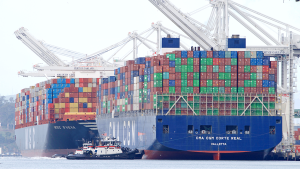Executives from the concrete and lumber supply sectors were in the hot seat recently as the Canadian Construction Association (CCA) held a webinar to address construction supply chain disruptions in the past year.
Derek Nighbor, president and CEO of the Forest Products Association of Canada, was asked about soaring lumber prices while Bart Kanters, president of the Ready Mixed Concrete Association of Ontario, described how his members have had to ration supplies.
A third panellist, Ed Whalen of the Canadian Institute of Steel Construction, got off lightly given that, as he said, it has generally been business as usual for steel suppliers.
The Oct. 22 session was hosted by CCA president Mary Van Buren, who besides prices and capacity also asked the panellists about pandemic subsidies, tariffs, advocacy and stimulus.
There has been a combination of factors at play on both the supply and demand sides leading to price hikes in lumber, Nighbor explained. Lumber stocks in B.C. were beset by pests and fires in 2017 and 2018 with the pine beetle devasting pine forests.
“The chickens, sadly, have come home to roost,” he said. “As a result, mills have been scrambling for supplies.”
Nighbor has heard questions asking why Canada is still exporting lumber to the U.S. when there are shortages in Canada. But there has been no major change in exports year over year, he asserted.
With less harvesting, the “allowable cut,” which is a measure of how many trees the sector is permitted to take, dropped so there is less wood getting into the mills.
“There were too many mills chasing too few trees, too be honest,” Nighbor said.
Finally there was a host of support issues including a strike, rail blockades and even a toilet paper surge early in the pandemic.
Lumber demand in 2020, on the other hand, has been unpredictable, Nighbor said.
On March 15, order sheets collapsed and buyers cancelled orders. There was a 30-per-cent drop in lumber prices the first four weeks of the pandemic.
Then came a surprising spike in activity.
“In our sector we didn’t anticipate the home renovation market,” said Nighbor. “People sitting in their kitchens staring at that bathroom that needed to be fixed, people saying they needed a bigger house, and they had more disposable income too, so we saw that surge then in lumber and we are still catching up.”
One of the first questions from the webinar audience went to Nighbor. What would prices look like in future, one contractor asked, considering that he has been forced to include 30 or 40 per cent higher lumber costs in recent bids.
Nighnor said prices levelled off in September and are starting to trend downwards.
“We did see a tripling of prices over a few months but that was based on a really difficult 2019,” he remarked.
“We are not caught up but we are catching up.”
Some mills are shuttered in B.C. due to the supply problem but those that are running are busy.
Still, there are a lot of uncertainties including whether President Donald Trump will leave office if he loses the vote next month.
“There is so much beyond our control that I hesitate to predict,” he said of prices.
It’s been an unusual year for the concrete and cement industries as well, with supplies of Portland cement at a low and concrete supplies affected by lockdowns regionally especially in Ontario and Quebec, Kanter said.
The sector usually does maintenance work in March and April, Kanter said, but that was postponed because of shutdowns. That work was undertaken in June and July, slowing production at that time.
Then, after the shutdown, demand unexpectedly started outpacing supply.
“The demand has increased significantly. And in Ontario we have had very favourable weather for concrete placing,” Kanter explained.
“We have not been in a situation where rationing is taking place, where someone needs 150 tonnes in a given day and they can only get 135.”
Normally deliveries are made within two days of an order but the wait is now two weeks. In addition, supplementary materials such as slag and fly ash are in short supply.
Kanter offered strategies for buyers.
“For ready mix concrete there is a lot more interaction with the contractor,” Kanter said. “For larger placements, or placements that have a lot of supplementary cement materials, we need to know one to two weeks in advance.
“It is not like we are shutting down the doors and saying we are not delivering concrete or something crazy like that, it’s how can we manage the demand and try to be respectful of all the customers we have out there.”
Meanwhile, the plants are working around the clock and weekends, he said.
As for the future, he expects the traditional cycles of the construction sector to bring normalcy back to the market — perhaps within eight weeks, when demand slows because of cold weather.
“That will slow things and allow us to build more reserves up,” said Kanter.
Follow the author on Twitter @DonWall_DCN.











Recent Comments
comments for this post are closed